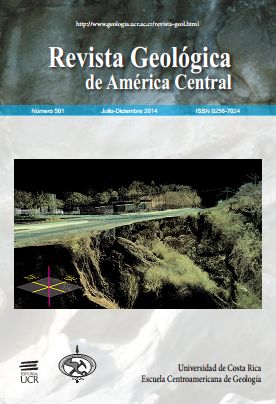Abstract
The H/V, FK and SPAC techniques were applied , all based on the measurement of ambient vibrations generated by surface waves for the characterization of soils beneath 15 selected sites, 12 of them corresponding to accelerographic stations of the Earthquake Engineering Laboratory of the University of Costa Rica. To achieve this, sensors (triaxial geophones) were placed in circular arrays and spectral ratios (from H/V) dispersion curves (from FK) and autocorrelation curves (from SPAC) for each site were obtained. Based on the above, the soil type was determined according to the characteristic site period (T0) read from H/V and criteria according to Zhao et al. (2006). Each site was also classified according to the Seismic Code of Costa Rica (2010) and Vs30 parameter calculated from the inversion of dispersion and autocorrelation curves. T0 values from 0.3 s to 1.5 s and Vs30 between 244 m/s to 379 m/s were obtained, indicating that soils correspond to S3 (soft soil, 67% of all cases). No site whose classification corresponds to S1 (rock) or S4 (very soft soil) was found
References
AKI, K., 1957: Space and time spectra of stationary stochastic waves, with special reference to microtremors.- Bull. Earthquake Res. Inst. Tokio, 35: 415-456.
BUILDING SEISMIC SOCIETY COUNCIL (BSSC), 2003: The 2003 NEHRP recommended provisions for new buildings and other structures, Part 1 (Provisions) and Part II (Commentary).- FEMA 368/369, Washington D.C.
COLEGIO FEDERADO DE INGENIEROS Y DE ARQUITECTOS DE COSTA RICA (CFIA), 2010: Código Sísmico de Costa Rica 2002 [4ta ed.].- 288 págs. Editorial Tecnológica de Costa Rica, Cartago.
KRAMER, S. L., 1996: Geotechnical earthquake engineering.- 653 págs. Prentice-Hall, New Jersey.
NAKAMURA, Y., 1989: A method of dynamic characteristics estimation of subsurface using microtremor on the ground surface.- Railways Technical Res. Inst. Quarterly Reports, 30(1): 25-33.
SESAME EUROPEAN RESEARCH PROJECT, 2004: Guidelines for the implementation of the H/V spectral ratio technique on ambient vibration. Measurements, processing and interpretations.- 62 págs. European Commission - Research General Directorate, Project No. EVG1-CT-2000-00026 SESAME.
WATHELET, M., 2007: Array recordings of ambient vibrations: surface-wave inversions.- 185 págs. Université de Liège, Bélgica [Tesis Ph.D].
ZHAO, J., ASANO, A., FUKOSHIMA, Y., IRIKURA, K., JOHN, X., OGAWA, H., OHNO, Y., OOUCHI, T., SOMERVILLE, P. G., TAKAHASHI, T. & ZHANG, J., 2006: An empirical site-classification method for strong-motion in Japan using H/V response spectral ratio.- Bull. Sesism. Soc. Am. 96(3): 914-925.


